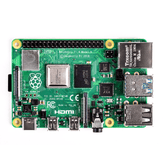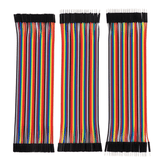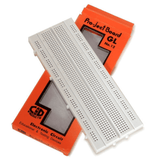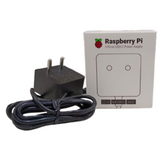Interfacing Ultrasonic Sensor with Raspberry Pi 4 GPIO
Summary
Ultrasonic sensors are widely used for distance measurement, but how do they actually work? This blog delves into the science behind ultrasonic sensors and provides a step-by-step guide on how to calculate the distance between the sensor and an object. It also includes a tutorial on interfacing the popular HC-SR04 ultrasonic sensor with a Raspberry Pi, complete with code examples and wiring diagrams. If you're looking to use ultrasonic sensors in your next project, this blog is a must-read.
Introduction
In this comprehensive guide, we explore the science of ultrasonic sensors and walk you through the process of interfacing an ultrasonic sensor with Raspberry Pi for precise distance calculations.
The Raspberry Pi 4 is a powerful and versatile tool for makers, entrepreneurs, scientists, hobbyists and engineers. Its unique capabilities make it perfect for interfacing with an ultrasonic sensor to measure distances or detect obstacles. By combining the power of the Raspberry Pi 4 processor together with an Ultrasonic Sensor you can get accurate readings from up to 5 meters away in virtually any environment without using line-of-sight technology!
The combination allows precision monitoring of objects within view while avoiding interference from other sources of radiation such as heat or light waves that may otherwise distort results. With its reliable sensing capability coupled with fast data processing speed; this system makes it possible to accurately monitor distance changes quickly at any time – making sensors like these ideal tools when accuracy matters most!
Before starting with the project let's understand how ultrasonic sensor works:
How Ultrasonic Sensors Work?

An ultrasonic sensor is a sensor that transmits ultrasonic sound waves and receives them back to calculate the distance from the object. It is used in lots of applications like obstacle avoidance robots, measuring liquid in bottles, etc. It's similar to SONAR technology used in ships to calculate the depth of the ocean.
Now let us look at the HC-SR04 ultrasonic sensor particularly. HC-SR04 ultrasonic sensor has 4 important pins. Let's understand them properly.
VCC and GND are power supply pins.
Trig pin:
Sends the ultrasonic wave which hits the target object and gets reflected or echoed back.
Echo pin:
This reflected/echoed wave is received by the receiver which makes this echo pin go from the initial state of HIGH(goes high 5v when trig pin transmits wave) to LOW(goes low when the wave is received).
Note: Sending 5V output signal from echo pin to GPIO of Rpi ( rated at 3.3v) would damage the pin. To solve this problem we will be using a level shifter for this pin.
Also, read our blog on Ultrasonic Sensor Working Principle detailing the principles and workings of these sensors, their applications, and how are ultrasonic sensors used.
How to calculate the distance between the ultrasonic sensor and the object?
![]()
![]()
Note:
Speed of sound is 340 m/s in air medium. To calculate the distance in cm, the speed of sound is 34000 cm/s. We will be using this formula later in our code. Now we have understood what is an ultrasonic sensor and how it works let's start making the project now.
Interfacing HC-SR04 with Raspberry Pi
In this project we will be using the following components:
- Raspberry Pi 4 B
- HC-SR04 ultrasonic sensor module
- 1K ,2K Resistors
- Jumper cables
- Breadboard
- Rasberry Pi official power supply adapter

Raspberry pi 4 B is the latest version of RPI which is very fast compared to its predecessors and also easy to use. We will be using this board in our project.
Pinout Diagram of Raspberry Pi 4 B

Above is the pin diagram for RPi 4 B. It can come in handy in not only this project but any Rpi project.
Pinout diagram of Ultrasonic sensor HC-SR04

Vcc and ground are power supply pins. Trig and echo are used to transmit and receive the ultrasonic pulse.
How To Connect Ultrasonic Sensor to Raspberry Pi
To connect your ultrasonic sensor with Raspberry Pi, make the connections as shown in the below diagram:
The trigger pin of the ultrasonic sensor goes to the GPIO 11 (physical PIN is 23) of RPI via the level shifter. The echo pin of the ultrasonic sensor goes to GPIO 12 ( physical PIN 32) of RPI. The 5V and GND pin of ultrasonic sensor is connected to 5V and GND of Raspberry Pi respectively.

Voltage divider circuit

Above is the level shifter circuit made using resistors to bring echo pin level from 5V to 3.3V. Here echo pin of the ultrasonic sensor works on 5V whereas the RPI GPIO pin work on 3.3 V. To make compatible between two different voltages this circuit is used.
Now the connections are done we can start coding!
Python code for interacting Raspberry Pi 4 with ultrasonic sensor HC-SR04
Following is the code for ultrasonic sensor interfacing with Raspberry Pi 4.
.
Note: Text following ‘#’ character in the below code are all comments added which will help you to understand the code.
#Raspberry Pi 4.0 code for interfacing with ultrasonic sensor
import RPi.GPIO as GPIO #imports modules required in program
import time #time module is used to add delays
GPIO.setmode (GPIO.BCM)
#Activates broadcom chip specific pin numbers.
#GPIO.setmode (GPIO.BOARD) -activates board pin numbers.
TRIG_PIN=11 #assign TRIG_PIN variable to GPIO pin 11
ECHO_PIN=12 #assign ECHO_PIN variable to GPIO pin 12
GPIO.setup(TRIG_PIN,GPIO.OUT) #trig pin is output
GPIO.setup(ECHO_PIN,GPIO.IN) #echo pin is input
GPIO.OUTPUT(TRIG_PIN,GPIO.LOW) #drives trig pin to 0V
time.sleep(2) #delay of 2 seconds
GPIO.output(TRIG_PIN,GPIO.HIGH) #set trig pin high
time.sleep(0.00001)
#keeps trig pin high for 10 microseconds
#this is used to trigger/start the ultrasonic module
#sends 8 ultrasonic bursts at 40KHz.
GPIO.output(TRIG_PIN,GPIO.LOW) #Set trig pin low
while GPIO.input(ECHO_PIN)==0: #check when the echo pin goes low and
pulse_send=time.time() #note down this time stamp in pulse_send
while GPIO.input(ECHO_PIN)==1: #check when the echo pin goes high and
pulse_received=time.time() #note down this time stamp
pulse_duration=pulse_received-pulse_send
#Pulse duration is the time difference between when the pulse was received #and sent.
pulse_duration=round(pulse_duration/2,2)
#The round function rounds off the value upto 2 decimal places.
distance= 34000*pulse_duration
#calculate and display the distance
print "Object is at ",distance,"cm from the ultrasonic sensor"
GPIO.cleanup()
#cleans/resets all the ports/pins used in the program.
#speed = distance/time
#distance=speed * time
#speed of sound is 340 m/s in air medium
#To calculate the distance in cm, the speed of sound is 34000 cm/s
#note that we have to calculate the distance from the ultrasonic sensor to the #object
# but here pulse duration we have considered is from the time it is sent #till it hits the target and comes back.
# But as we noted earlier we just need distance #from ultrasonic #sensor #to object
#so our pulse duration will be half
Conclusion
In this blog, we explored how to interface an Ultrasonic Sensor with Raspberry Pi 4 GPIO. The Ultrasonic Sensor measures distance using sound waves and sends the data to the Raspberry Pi. The article explains the required hardware components, wiring, and code setup needed to make the sensor work.
This guide showcased the seamless integration of an Ultrasonic Sensor with Raspberry Pi, offering accurate distance measurements. If you found this information valuable, share your thoughts in the comments below.
Please do check out other blog posts about Ultrasonic sensor with raspberry pi 4 , Interfacing MPU6050 accelerometer with Raspberry Pi , Difference Between Arduino and Raspberry Pi , Raspberry Pi vs Beaglebone ,DS18B20 with Raspberry Pi Pico , DS18B20 with Raspberry Pi Pico using MicroPython , How to use Raspberry Pi as node in LoRAWAN , NODE TO NODE COMMUNICATION ON LORA WITH RASPBERRY PI 4 and Controlling Speed and Led Brightness of Robot Using Raspberry Pi.
Make sure you check out our wide range of products and collections (we offer some exciting deals!)












